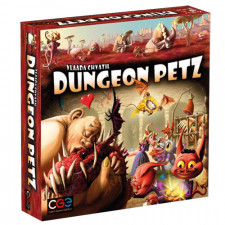Dungeon Petz Review
on Aug 5, 2015
Full disclosure up front: I’m a huge fan of Vlaada Chvatil’s designs. And that trend continues with the marvelous Dungeon Petz. The players take over families of imps who have escaped their Dungeon Lords and decided to raise these titular petz. But, despite the somewhat cutesy theme, this game is of a medium/heavy weight and requires shrewd play for success.
Dungeon Petz is a worker placement/auction hybrid. Each player gets an equal number of imps. However, they are not placed one at a time. Instead, players secretly group them and can include gold as well. So, if I have a group of three imps, and your biggest group is two, I’ll get to place my group first – meaning I’ll have access to better spots. In this way, players are pulled between fewer big groups (hopefully grabbing the best spots) or many smaller groups (going for quantity over quality).
On the board, players can buy new pets, get stronger cages or cage enhancements, grab pet food, obtain artifacts, or even offer to help judge the next exhibition – which gets you a few bonus exhibition points. Being on the judge’s panel has its perks.
Once all actions are taken, players must then satisfy their pets. Pet needs are represented by cards that are drawn semi randomly. Rage needs require a strong cage and magic needs require anti-magic fortification. Play needs mean imps have to stay back to entertain them and food needs require that they eat. Sometimes they even need to poop.
But it isn’t so simple as just getting resources and spending them. You start the game with one card of each color. And, when it’s time to take care of pets, you get one card per need. That doesn’t give you much of a buffer. If your pet wants to eat (you drew cards requiring food), then you have to feed him. Didn’t get pet food? Your little guy gains suffering. Didn’t play with him? Suffering. Too much poop and disease? Suffering. If your pet gets too much suffering, he dies and, as stated in the rules, you must feel bad. Similarly, if your pet breaks out of his cage or mutates, you will also lose the pet.
Once pet needs are met, you get to have an exhibition where some trait is put on display. Sometimes the exhibitors want to see magic pets, other times, the most playful or even the angriest. Looking at upcoming exhibitions, and getting your petz to match, is a much needed talent.
And then, the time comes for you to bid adieu to your pets. Each round, you can sell one pet to the dungeon lord customers. Each lord wants something a little different and your reputation (points) will be enhanced based on how well you meet that lord’s needs.
Dungeon Petz is a bit of a fake-out. Cute theme, pretty artwork, fun rules (when a pet goes unsold, it goes to live on a farm, but you also add an extra meat to the available food for the next round). This seems like a game meant to appeal to the lighter crowd. It is not, I repeat, not a light game. This is definitely on the medium/heavy side of things and is certainly meant for gamers.
Dungeon Petz is wonderful because it requires so much planning, but also puts you in charge of pets that, simply put, cannot be fully predicted. Since the card draws provide you with the needs that round, you can’t always predict in advance what your pet will require. When your pet is young and has only two or three needs, your buffer of one card is sufficient. But as they get older, it gets harder and harder – especially if you have multiple pets. You have one imp left. Do you grab that awesome looking artifact sitting out there? Or do you hold him back in case your pets need to be played with?
While it shares little in common with a “push your luck†game, players are incentivized to get as many needs as possible. After all, if I have three needs showing, I can meet at most three for purposes of exhibition or sale. But on a mature pet with seven need cards, I can get many more points for exhibition or sale … assuming he doesn’t break out of his cage or suffer too badly from unmet needs.
It often feels like you are riding the edge. You are constantly facing the loss of pets, reputation, and actions as you play. And the feel is exhilarating. Plus, each time you need to meet needs, especially with more than one pet, you have a little puzzle that must be solved to make the most efficient use of your resources.
Dungeon Petz is best with four but it scales well with two and three. In those instances, certain action spaces are blocked each round so that players don’t have access to too many spaces and the competition remains fierce. So fierce, in fact, that typically one player does not get a pet on the first turn. While this would seem to be a huge detriment, it often allows them to prepare better on that first turn and then grab a good pet to start with in round two.
The only potential negative is the mismatch of theme and gameplay. The theme is light and cutesy. It may seem perfect for non-gamers or for a spouse that eschews wizards and orcs. And theme-wise, that’s true. But the gameplay is deep and heavy. It is not a gateway game and could easily overwhelm a casual or nongamer. On the other hand, I have one gamer friend who refuses to play it because the animals poop. He finds the theme too … immature and therefore it doesn’t suit him.
I don’t think that will be a problem with most gamers, but it’s worth noting that your group must be able to engage in a little humorous fun around what is essentially a gamer’s game.

 Customer Support
Customer Support  Subscribe
Subscribe 




 Account
Account  Wishlist
Wishlist 

